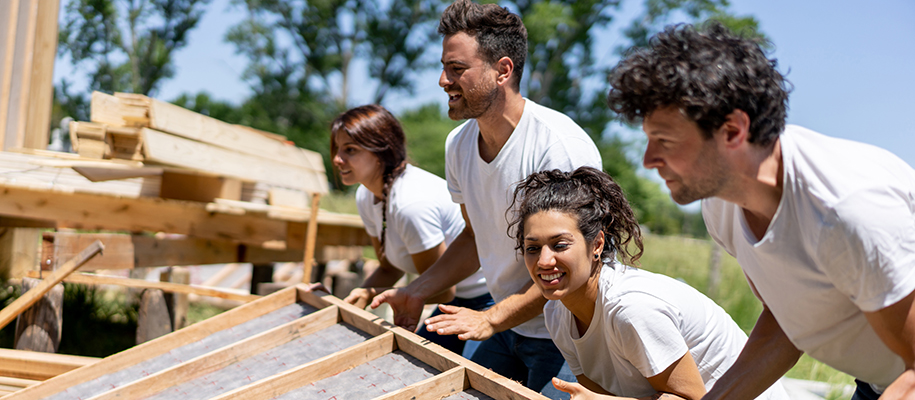Service learning is a method of teaching and learning that combines academic experiences with meaningful service experiences. Certainly, effective classroom pursuits are critical for success in college. At the same time, community service can help you experience things you might not learn otherwise. Put these two elements together and things really come together. When community service and classroom learning function in tandem, they produce a synergy that adds new dimension to your college experience.
What is service learning?
Service learning is an education model that combines classroom theory with real-world action. Brooke Oehme, the Coordinator of Volunteerism and Service Learning at Mount Mercy University, describes it as the process of “applying your education in real-world situations. Service learning is where you truly get to learn who you are as a person and how you can actively live out the beliefs you hold.” In a service learning model, students are not just vessels to fill with facts and figures. For deep, enduring learning you need to be an active participant in the planning, the doing, and the finding of your voice. New connections emerge in this approach to education. In the “service + learning” equation, the result is often beyond what you would expect from simple arithmetic.
Is service learning the same as volunteering?
Volunteering is important as well, but it’s not quite the same as service learning. One of the major differences between the two is process. Showing up to serve food in a soup kitchen is a great way to volunteer. True service learning is different because it links community need with a classroom topic. You take theory and put it into practice, and you take the project from concept all the way to completion. Being involved from the very beginning is at the heart of service learning.
For example, you might investigate the topic of soup kitchens—who needs help, where they are located, and what resources you need to make a kitchen work. You could learn from sociologists, social workers, statisticians, and chefs. Then you plan a menu and get your hands dirty as you get the kitchen up and running. Afterward, you carefully review what you learned so you can take it to the next level and share your findings with others.
These are complex problems in complicated situations; they are not simple textbook exercises. But don’t throw your textbook out just yet! Your knowledge of the textbook, or the cookbook even, prepares you to work in a messy real-life kitchen. The “right answers” aren’t in the back of the book—service learning takes the classroom to the street and links these learning models to help you reach new levels of understanding and experience.
Related: An Easy How-to Guide to Start Volunteering as a Student
What does the research say?
Researchers in the Higher Education Research Institute at the University of California Los Angeles found students who participated in service learning demonstrated greater engagement in the classroom, an increased sense of personal identity, and a heightened awareness of the world around them. The data identified a positive impact on interpersonal skills—like working with others, leadership, and communication—spiritual growth, and moral development.
Analysts at Vanderbilt University reviewed service learning research, finding both students and faculty members reported positive learning effects, such as strengthened critical thinking and problem analysis abilities. This is because service learning participation increases how often students discuss their experiences, intensifies how they learn from one another, and amplifies the emotional and analytical support from faculty members. From social justice to sustainability, service learning has an impact. Learning takes on a new meaning because the experiences are shared. Peer discussions are meaningful and dynamic. The power of reflection guided by instructors and mentors connects personal experiences to classroom studies. Service learning is good for the mind as well as the soul.
What do students say about it?
“Living with others in a group and reflecting on myself individually, I remembered many of the qualities that bring me happiness and hardship, comfort and insecurity, and understanding and inspiration. I learned many of the values that are most important to my being…Do it! I rediscovered insights about myself I haven’t thought of for many years. I remembered to love myself as I should love others—and love others with all my heart.”
— Chris Emery, Mount Mercy University, Service learning trip to Appalachia
“I realized I love helping people in whatever way I can...There’s so much you can do!”
— Cathleen Brehm, Mount Mercy University; McAllen, Texas, service learning project
Related: The Impact of the Pandemic on College Mission Trips
Why should I participate in service learning?
Serving puts theory into action. You can see—and experience—how different ideas work (or don’t work) in your community and the world. “Any student engaged in a liberal arts education can benefit from a service learning approach,” Oehme says. “Areas of math, science, government, education, philosophy, ethics, religion, and others all find connection with service learning.” Students also benefit from the cross-disciplinary nature of service. “Service-oriented organizations often cross the boundaries of specific disciplines, engaging an individual’s business skills, political knowledge, education theory, and ethical philosophy in a single program. The life lessons students gain from service learning also work to enrich the rest of their college experience, giving them an advantage in the classroom as well as in the real world,” she adds. Like so many educational opportunities, what you get out of service learning depends on what you put into it.
How can I get involved?
The first step is simply recognizing a need, and the second is finding out the opportunities your school offers. Many colleges and universities offer service learning programs, and these programs make it easy to join with friends and classmates. Read signs on the dining hall wall or campus center bulletin boards. Which ones jump out at you? Visit your school’s student government association, campus ministries office, or volunteer center to learn more about your options.
For example, Mount Mercy University offers service learning and volunteerism through its Campus Ministry department, which coordinates several trips and activities organized by faculty or staff members, and it’s offered at a low or no cost to students. If your college doesn’t offer a formalized service learning program, it may be able to partner with a local nonprofit or sponsor educational seminars, food kitchens, or other community programs. “There’s no limit to the ways you can serve the community,” Oehme says. You may work with a handful of friends to offer a community workshop aimed at athletics, theater, art, or science. Maybe you’ll help rebuild a community after a flood, fire, or tornado. Local service efforts are always happy to receive assistance from students, and well-established organizations can often help develop student programs in your community, even if your college doesn’t have a service learning curriculum.”
Related: All About Service Learning Opportunities on College Campuses
If you’re passionate about a cause not yet supported on campus, then this is your chance to make a difference. Rally your classmates, work with your advisor, or talk to a professor about adding a service learning component to a course. See the need, meet the need!
Religious colleges are well-known for employing service learning models. Explores these colleges and universities by checking out our featured Christian schools and featured Catholic schools.





